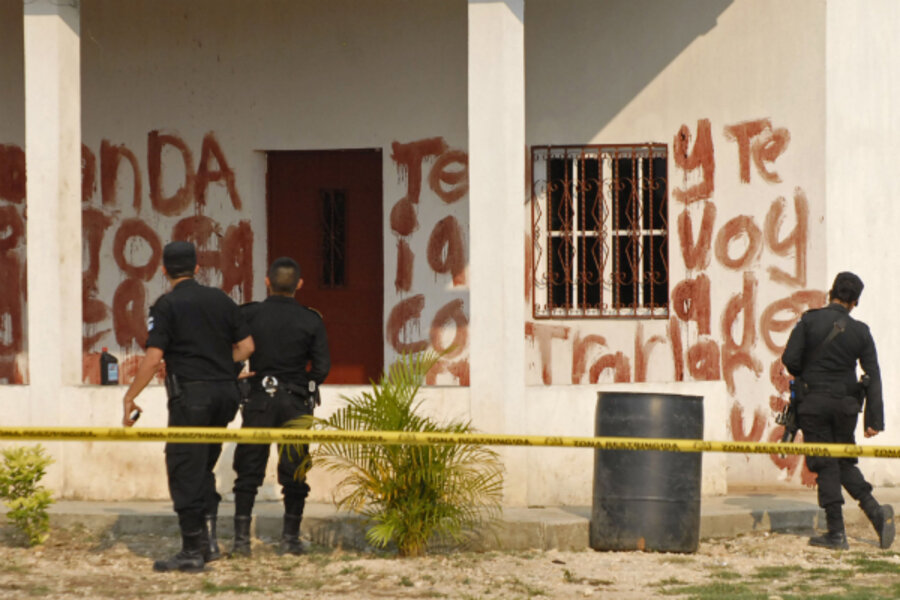Guatemala massacre points to influence of Mexican drug gang
Loading...
A massacre in northern Guatemala, which has left at least 27 people dead, is another reminder of the growing influence exerted by powerful Mexican drug gang, the Zetas, in Central America.
The Zetas may have first entered Guatemala at the invitation of two drug bosses, Otoniel Turcios and Hearst Walter Overdick. But instead of partnering with local Guatemalan smugglers, the Mexicans became intent on displacing them.
The Zetas cemented their presence in Guatemala in 2008, when they ambushed and killed local crimelord Juan Jose Leon. Dislodging the Leon clan gave the Zetas power over key trafficking routes in the northern departments of Zacapa, Alta Verapaz, and Peten. It was in the latter that the recent massacre took place. In Peten, the government has now declared a "state of siege" similar to the security surge that failed to drive Zetas from Alta Verapaz at the end of last year.
As proved by the Peten killings, the Zetas' presence in Guatemala has drawn attention because of their willingness to use brutality. In contrast to the other Mexican cartel with sizeable presence in Central America, that of Sinaloa, the Zetas have frequently used extreme violence to establish control over a territory. While the Sinaloans have attempted to maintain their operations in Guatemala's western Huehuetenango department by buying the silence of authorities and negotiating deals with local traffickers, the Zetas have proven themselves more disposed to fight and kill their rivals.
IN PICTURES: Mexico's drug war
In other Northern Triangle countries, the Zetas have been more accomodating to local gangs, although no less ambitious in expanding their operations. As recently noted by El Salvador President Mauricio Funes, the Zetas have made contact with gangs like the Mara Salvatrucha (MS-13) and the Barrio 18 (18), which echoes statements made by the president and the defense minister in 2010.
In El Salvador, the Zetas use gangs as drug peddlers and hired assasins, not for the purpose of trafficking cocaine via international routes. However, there is evidence that MS-13 is interested in deepening their relationship with the Zetas, with some cells reportedly soliciting training in combat from the Mexicans.
Like Guatemala, where the Zetas have recruited from the army's special forces unit, the Kaibiles, the Mexican group has also reportedly attempted to recruit members of the security forces in El Salvador, according to officials. In July 2010, a former Salvadorean police officer was killed in a shootout with the Mexican army in Nuevo Leon, one of nine police agents who may have found work with the Zetas in Mexico, reports El Salvadorean paper El Diario de Hoy.
In Honduras, the Zetas are based in the departments of Olancho and Cortes, managing air and sea routes for the trafficking of cocaine. Here, there is also evidence of the Zetas using local gangs as hired guns: in February 2010, Honduran intelligence officials said they intercepted a note in which Barrio 18 discussed receiving payment from the Zetas, in exchange for killing the security minister. The Mexican gang has also been able to establish control over human smuggling and arms trafficking routes in the country, according to one report.
Elsewhere in Central America, there is little evidence of the Zetas wielding the same kind of power and influence as they do in the Northern Triangle. In Costa Rica, where the murder rate has doubled since 2000, reaching 11 homicides per 100,000 residents last year, the increased violenced is blamed on drug trafficking. But while the Sinaloa Cartel is known to have a powerful presence here, the Zetas are not yet believed to have arrived. Similarly, in Nicaragua, the Zetas are not thought to maintain personnel inside the country.
--- Elyssa Pachico is a writer for Insight – Organized Crime in the Americas, which provides research, analysis, and investigation of the criminal world throughout the region. Find all of her articles here.
Sign up for our daily World Editor's Picks newsletter. Our best stories, in your inbox.





